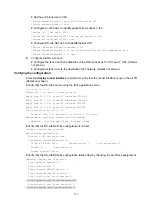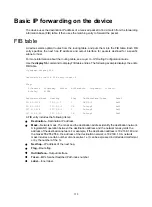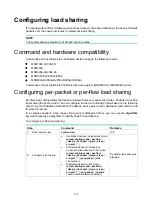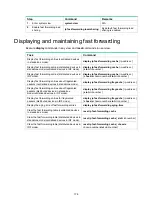
185
[RouterA-GigabitEthernet2/0/1] ip irdp multicast
# Specify the IP address 192.168.1.0 and preference 400 for GigabitEthernet 2/0/1 to
proxy-advertise.
[RouterA-GigabitEthernet2/0/1] ip irdp address 192.168.1.0 400
2.
Configure Router B:
# Specify an IP address for GigabitEthernet 2/0/1.
<RouterB> system-view
[RouterB] interface gigabitethernet 2/0/1
[RouterB-GigabitEthernet2/0/1] ip address 10.154.5.2 24
# Enable IRDP on GigabitEthernet 2/0/1.
[RouterB-GigabitEthernet2/0/1] ip irdp
# Specify preference 500 for advertised IP addresses on GigabitEthernet 2/0/1.
[RouterB-GigabitEthernet2/0/1] ip irdp preference 500
# Specify the multicast address 224.0.0.1 as the destination IP address for RAs sent by
GigabitEthernet 2/0/1.
[RouterB-GigabitEthernet2/0/1] ip irdp multicast
# Specify the IP address 192.168.2.0 and preference 400 for GigabitEthernet 2/0/1 to
proxy-advertise.
[RouterB-GigabitEthernet2/0/1] ip irdp address 192.168.2.0 400
Verifying the configuration
# Display the routing table for Host A.
[HostA@localhost ~]$ netstat -rne
Kernel IP routing table
Destination Gateway Genmask Flags Metric Ref Use Iface
10.154.5.0 0.0.0.0 255.255.255.0 U 0 0 0 eth1
192.168.1.0 0.0.0.0 255.255.255.0 U 0 0 0 eth1
192.168.2.0 0.0.0.0 255.255.255.0 U 0 0 0 eth1
0.0.0.0 10.154.5.1 0.0.0.0 UG 0 0 0 eth1
The output shows that the default route on Host A points to IP address 10.154.5.1, and Host A has
routes to 192.168.1.0/24 and 192.168.2.0/24.
# Display the routing table for Host B.
[HostB@localhost ~]$ netstat -rne
Kernel IP routing table
Destination Gateway Genmask Flags Metric Ref Use Iface
10.154.5.0 0.0.0.0 255.255.255.0 U 0 0 0 eth1
192.168.1.0 0.0.0.0 255.255.255.0 U 0 0 0 eth1
192.168.2.0 0.0.0.0 255.255.255.0 U 0 0 0 eth1
0.0.0.0 10.154.5.1 0.0.0.0 UG 0 0 0 eth1
The output shows that the default route on Host B points to IP address 10.154.5.1, and Host B has
routes to 192.168.1.0/24 and 192.168.2.0/24.
















































